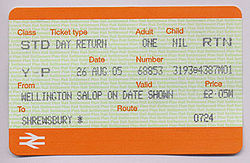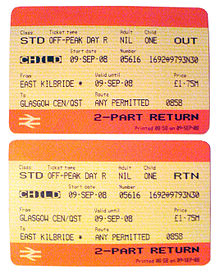- National Rail
-
For the Australian railway operator of the same name, see National Rail Corporation.Not to be confused with Network Rail.
National Rail 
Type Public transport Owner ATOC Country  United Kingdom
United KingdomIntroduced 1999 Related brands National Rail Enquiries Markets United Kingdom Previous owners British Rail Website http://www.nationalrail.co.uk National Rail is a title used by the Association of Train Operating Companies (ATOC) as a generic term to define the passenger rail services operated in Great Britain (before the adoption of the term National Rail, "Great Britain Passenger Railway" was used). ATOC is an unincorporated association whose membership consists of the passenger train companies of Great Britain which now run the passenger services previously provided by the British Railways Board (from 1965 the Board used the title British Rail). National Rail generally does not include services that do not have a BR background; this distinction is important because National Rail services share a ticketing structure and inter-availability that do not necessarily extend to other services.
The National Rail logo was introduced by ATOC in 1999, and was used on the Great Britain public timetable for the first time in the edition valid from 26 September in that year. Rules for its use are set out in the Corporate Identity Style Guidelines published by ATOC, and available on its website.[1] The current edition is dated 2006, but there has been at least one previous version, dated 2000. The NR title is sometimes described as a "brand" but this, according to ATOC, is incorrect. The 2000 guidelines said: 'It has not been designed as a brand or identity, but to explain to rail travellers that there is a National Rail network and material carrying this descriptor covers all passenger Train Companies.'
Contents
National Rail and Network Rail
National Rail should not be confused with Network Rail. National Rail is a title used to promote passenger railway services, while Network Rail is the organisation owning and managing the fixed assets (tracks, signals etc.) of the railway network.
The two networks are generally coincident where passenger services are run. Most Network Rail lines also carry freight traffic and some lines are freight only. There are some scheduled passenger services that do not run on Network Rail lines, for example Heathrow Express and The London Underground.
Train operating companies
Main article: List of companies operating trains in the United KingdomAbout 20 privately owned Train Operating Companies, each franchised for a defined term by government, operate passenger trains on the main rail network in Great Britain. The Association of Train Operating Companies is the trade association representing the TOCs and provides several core services, including the provision of the National Rail Enquiries service. It also runs Rail Settlement Plan (which allocates ticket revenue to the various TOCs) and Rail Staff Travel which manages the travel facilities for railway staff. It does not compile the national timetable, however, which is the joint responsibility of the Office of Rail Regulation (allocation of paths) and Network Rail (timetable production and publication).
Design and marketing
Since the privatisation of British Rail there is no longer a single approach to design on railways in Great Britain. The look and feel of signage, liveries and marketing material is largely the preserve of the individual companies operating trains and stations.
However, National Rail continues to make use of British Rail's famous double-arrow symbol, designed by Gerald Burney of the Design Research Unit. It has been incorporated in the National Rail logotype and is also displayed on tickets, the National Rail website and other publicity. The trademark rights to the double arrow symbol remain state-owned, now being vested in the Secretary of State responsible for railway transport.
It seems likely that the continued use of the symbol immediately after privatisation had more to do with convenience than design: changing it would have made obsolete all the road signs using it to indicate railway stations. Individual operators would also have had no more right than any other private company for their "advertisement" to appear on traffic signs, whereas the double arrow (and/or the LU symbol or a PTE symbol if appropriate) was already prescribed for indicating a "railway station".[2] However, in recent times the symbol has had a renaissance, and new stations now display it.
The lettering used in the National Rail logotype is a modified form of the typeface Sassoon Bold. Some train operating companies continue to use the former British Rail Rail Alphabet lettering to varying degrees in station signage, although its use is no longer universal; however it remains compulsory (under Railway Group Standards) for safety signage in trackside areas and is still common (although not universal) on rolling stock.
It is a common misconception that Rail Alphabet was also used for printed material, but with the exception of actual logos ("British Rail", etc.) this has never been the case. The British Rail typefaces of choice from 1965 were Helvetica and Univers, with others (particularly Frutiger) coming into use during the sectorisation period after 1983. Today's operating companies may use what they like: some examples include Futura (Stagecoach Group), Helvetica (FirstGroup and National Express), Frutiger (Arriva Trains Wales), Bliss (CrossCountry, which is also an Arriva franchise but not branded as such), and a modified version of Precious by London Midland.
Although the companies which belong to ATOC technically compete against each other, the strapline which National Rail uses to accompany its logo is 'Britain's train companies working together'.
Other passenger rail operators in Great Britain
See also: Commuter rail in the United KingdomSeveral conurbations in Great Britain have their own metro or tram systems, most of which are not part of National Rail. These include the London Underground, Docklands Light Railway, Blackpool Tramway, Tramlink, Glasgow Subway, Tyne and Wear Metro, Manchester Metrolink, Sheffield Supertram, Midland Metro and Nottingham Express Transit. On the other hand, the largely self-contained Merseyrail system is part of the National Rail network, and urban rail schemes around Birmingham, Cardiff, Glasgow and West Yorkshire consist entirely of National Rail services.
London Overground (LO) is a hybrid: its services are operated via a concession awarded by Transport for London, and are branded accordingly, but until 2010 all its routes used infrastructure owned by Network Rail. LO now also possess some infrastructure in its own right, following the reopening of the former East London line of London Underground as the East London Railway of London Overground. Since all the previous LO routes were operated by National Rail franchise Silverlink until November 2007, they have continued to be shown in the National Rail timetable and are still considered for some purposes to be a part of National Rail.
Two further passenger services, Heathrow Express and Eurostar, are also not part of the National Rail network despite some sharing of stations (both) and routes (Heathrow Express and Heathrow Connect only). In addition, Northern Ireland Railways was never part of British Rail, and therefore is not part of the National Rail network.
There are many privately owned or heritage railways in Great Britain, listed in the list of British heritage and private railways, which are not part of the National Rail network and mostly operate their services for heritage or pleasure purposes rather than as public transport.
Ticketing
National Rail services have a common ticketing structure inherited from British Rail. Through tickets are available between any pair of stations on the network, and can be bought from any station ticket office. Most tickets are inter-available between the services of all operators on routes appropriate to the journey being made. A notable exception is for journeys between London and Gatwick Airport, for which, as of March 2006, three operators issue different tickets valid on their own services only. There is also a London-Gatwick ticket that is valid on all operators except Gatwick Express. Operators on some other routes offer operator-specific tickets that are cheaper than the inter-available ones.
Through tickets involving the services of Heathrow Express and London Underground are also available. Oyster pay-as-you-go can now be used on National Rail in Greater London as of 2 January 2010.
Passengers without a valid ticket boarding a train at a station where ticket-buying facilities are available are required to pay the full Open Single or Return fare. On some services penalty fares apply - a ticketless passenger may be charged the greater of £20 or twice the full single fare to the next stop. Penalty Fares can be collected only by authorised Revenue Protection Inspectors, not by ordinary Guards.
National Rail distributes a number of the technical manuals on which travel on the railways in Great Britain is based, such as the National Rail Conditions of Carriage, via their website.
Timetables
Pocket timetables for individual operators or routes are available free at staffed stations. A complete National Rail Timetable with up to 3000 pages was also available for purchase, but the last hard copy edition was published in May 2007. Complete timetables are still available in printed form from TSO (The Stationery Office) and also an independent publisher. [3]
A digital version of the formerly printed timetable as a pdf (portable document format) file is available without charge on the Network Rail website.[4] The National Rail Enquiries website, run by ATOC, includes a real-time journey planner, fares and live departure information.
See also
References
- ^ http://www.nationalrailguidelines.co.uk/level1/NRE/NRE_StyleGuidelines.pdf
- ^ Traffic Signs Regulations and General Directions 2002, Schedule 7
- ^ Bradshaw-Mitchell’s Rail times
- ^ Network Rail - Current Timetable
External links
National railway companies of Europe  HSH •
HSH •  HYU1 •
HYU1 •  ÖBB •
ÖBB •  ADY1 •
ADY1 •  BŽD/BČ •
BŽD/BČ •  SNCB/NMBS •
SNCB/NMBS •  ŽFBH2 and ŽRS3 •
ŽFBH2 and ŽRS3 •  BDŽ •
BDŽ •  HŽ •
HŽ •  ČD •
ČD •  DSB •
DSB •
 EVR •
EVR •  VR •
VR •  SNCF •
SNCF •  SR1 •
SR1 •  DB •
DB •  TrainOSE •
TrainOSE •  MÁV •
MÁV •  IÉ •
IÉ •  FS •
FS •  KTŽ1 •
KTŽ1 •  HK/KŽ4 •
HK/KŽ4 •  LDZ •
LDZ •  LG •
LG •
 CFL •
CFL •  MŽ •
MŽ •  CFM •
CFM •  ŽCG •
ŽCG •  NS •
NS •  NSB •
NSB •  PKP •
PKP •  CP •
CP •  CFR •
CFR •  RŽD •
RŽD •  ŽS •
ŽS •  ŽSR •
ŽSR •  SŽ •
SŽ •
 RENFE •
RENFE •  SJAB •
SJAB •  SBB/CFF/FFS •
SBB/CFF/FFS •  TCDD1 •
TCDD1 •  UZ •
UZ •  BR5 / NR6 / NIR71Country partly in Asia • 2For the Federation BH • 3For Srpska • 4State with limited recognition • 51948-2000
BR5 / NR6 / NIR71Country partly in Asia • 2For the Federation BH • 3For Srpska • 4State with limited recognition • 51948-2000
6Created in 1999, owned by ATOC • 7For Northern IrelandCategories:- Post-privatisation British railway companies
- 1999 establishments in the United Kingdom
Wikimedia Foundation. 2010.


